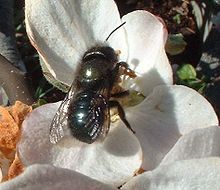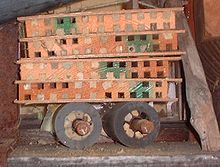- Orchard mason bee
-
Orchard Mason Bee 
Scientific classification Kingdom: Animalia Phylum: Arthropoda Class: Insecta Order: Hymenoptera Family: Megachilidae Genus: Osmia Species: O. lignaria Binomial name Osmia lignaria
Say, 1837Osmia lignaria, commonly known as the orchard mason bee or blue orchard bee,[1] is a megachilid bee that makes nests in reeds and natural holes, creating individual cells for their brood that are separated by mud dividers. Unlike carpenter bees, they cannot drill holes in wood. O. lignaria is a common species used for early spring fruit bloom in Japan, Canada, and the United States, though a number of species of other Osmia are cultured for use in pollination.
Contents
Life cycle
Spring
The bees begin to emerge from their cocoons in the spring when the daytime temperature reaches 14°C (57°F).[2] The males emerge first. They remain near the nesting site and wait for the females to begin their emergence, which can be several days to weeks depending on the number of days of warm weather. The first thing the females do is mate. A female will typically mate once, maybe twice. She will be absent from the nesting site for several days while she feeds and waits for her ovaries to fully mature.
When a female is ready, she seeks out a suitable nest. O. lignaria females like to nest in narrow holes or tubes, though they have been found to nest inside cedar shakes and even keyholes. Beekeepers put out pre-made nesting materials to entice the females to stay close to the orchard. Good nesting material (reeds, paper tubes, wood trays) are as important as having the right available mud (silty/clayey as well as correct moisture content to grab/pack the mud). A female might inspect several potential nests before settling in. Once she has found the right nest, she flies outside of the hole and does an in-flight dance. She is orienting on major visual features in order to find her nest when she returns from foraging.
O. lignaria arrange their nest as a series of partitions, with one egg per partition. She begins the process by collecting mud and building the back wall of the first partition. Then she makes trips to nearby flowers. Unlike honey bees which visit flowers that are miles away, she prefers flowers that are nearest the nest. She can visit 75 flowers per trip, and it takes 25 trips to create a complete pollen/nectar provision. She works tirelessly during the day, only stopping once the sun has gone down. When the sun rises the next morning, she will bask in its rays until she is warm enough to fly. Then she continues where ever she left off the day before.
Once the provision is complete, she backs into the hole and lays an egg on top of it. She collects more mud to seal off the partition. The new wall also doubles as the back wall of the next cell. She continues until she has filled the nest hole. O. lignara, like many insects, can select the gender of the egg they lay by fertilizing the egg, or not. Unfertilized eggs are males, while fertilized eggs are females. The adult bee lays female eggs in the back of the burrow, and the male eggs towards the front. She lays about three males to every nest hole depending on depth.
When the egg hatches, the larva consumes the food provision as it goes through many changes on its way to becoming an adult. It will spend most of its life alone in this dark cell made by its mother.
Once the female has finished the nest, she plugs the entrance with one thick mud wall. Then she seeks out another location for a new nest. She works tirelessly until she dies. An O. lignaria female lives for about four to eight weeks and she can complete an average of four 6-inch tubes in her lifetime, with about eight eggs per tube. That's nearly 60,000 blossom visits per female. Because of this farmers have cultivated the insect for pollination purposes in fruit orchards.
Summer
By the early summer, a larva has consumed all of its provisions and begins spinning a cocoon around itself and enters the pupal stage; the adult females die off as the season progresses.
Fall and Winter
The young bee is now a fully developed insect and diapauses inside its cocoon for the duration of the winter. They burn through their fat reserves to stay warm. If it stays cold for too long, the bees can die of starvation. Alternatively, if the temperature rises too fast, they may emerge before the blossom. Farmers are known to exploit their emergence cycle and time their release to coincide with the first orchard blossoms.
Defense
Orchard mason bees, like all mason bees, are very shy and will only sting if they perceive serious danger. It will not attack to defend itself. The stinger itself is actually an egg guide.
See also
Further reading
- How to Manage the Blue Orchard Bee, Bosch & Kemp
- The Orchard Mason Bee by Brian Griffin
- Trap-nesting Wasps and Bees: Life Histories, Nests, and Associates by Karl V. Krombein
References
- ^ Black, Scott Hoffman; Shepherd, Matthew; Vaughan, Mace; LaBar, Caitlin; Hodges, Nathan (November 2009), Yolo Natural Heritage Program (HCP/NCCP): Pollinator Conservation Strategy, Portland, OR / Sacramento, CA: The Xerces Society for Invertebrate Conservation, http://www.xerces.org/wp-content/uploads/2010/01/yolo-nhp_pollinator-strategy_xerces.pdf, retrieved March 24, 2011
- ^ Dr. Margeriet Dogterom (2002) "Pollination with Mason Bees" Beediverse Books
External links
- Orchard Mason Bees Gardening in Western Washington
- The New Mexico Native Bee Pollinator Project
- "How to raise Mason Bees" and Resource
Categories:- Pollinators
- Osmia
- Animals described in 1837
Wikimedia Foundation. 2010.



